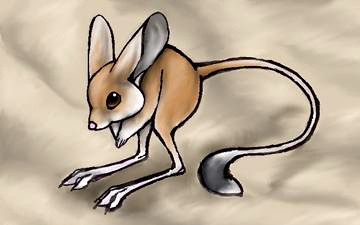The Long-eared Jerboa, Euchoreutes naso,[2] is a nocturnal mouse-like rodent with a long tail, long hind legs for jumping, and exceptionally large ears. It is distinct enough that authorities consider it to be the only member of both its genus,Euchoreutes, and subfamily, Euchoreutinae.
It has been reported in China and in ten localities in desert habitats of Trans Altai Govi Desert and the Gobi Desert in Mongolia. A large part of the species is believed to occur in Mongolia within protected areas. Very little is known about the species.
(From Wikipedia.org, August 2 2010)
– – –
Long-eared jerboa tail length is 150 to 162 mm, body length is from 70 to 90 mm. The tail is covered with short hairs that are similar in color to the rest of the body except for the terminal tuft, which is white and black. Upper parts are reddish yellow to a light russet color. The belly is white. The hind foot is 40 to 46 mm in length, with five digits. The two lateral digits are shorter than the three central ones. The central metatarsals are fused for a small distance. The feet are covered with tufts of bristly hairs. Long-eared jerboas have ears that are 1/3 longer than their heads. The incisors are thin and white. A small premolar can be found on each side of the upper jaw. Females have eight mammae. (Nowak, 1999)
(From Animal Diversity Web via The Encyclopedia of Life, August 2 2010)
– – –




